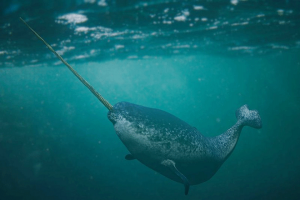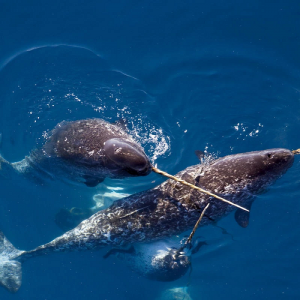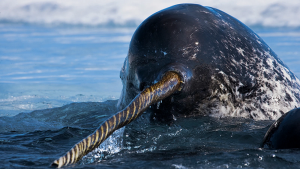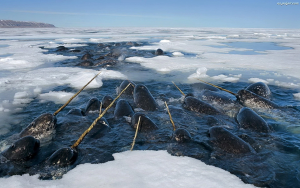The narwhal, also known as the narwhale, has the scientific name Monodon monoceros. This medium-sized whale is well-known for its distinctive, spiraled, horn-like tooth, often drawing comparisons to the mythical unicorn.
What appears to be a horn is actually a specialized tooth—an elongated, spirally developed canine similar to ivory. Male narwhals typically have a single tusk that grows throughout their lifetime, reaching lengths of 1.5 to 3.1 meters and weighing approximately 10 kg.

Most male narwhals have a left-side tusk, while only about 1 in 500 males develop a right-side tusk. Meanwhile, around 15% of female narwhals possess tusks, but theirs are much smaller and lack the spiral shape. There has only been one documented case of a female narwhal with two tusks. Interestingly, the tusk does not play a crucial role in daily life, as females without them live just as long as males.
Many theories suggest the tusk may be used for breaking ice, sensing temperature, navigation, or hunting, but none of these have been definitively proven.

During the Middle Ages, narwhal tusks were highly prized, with people believing that grinding them into powder could cure all diseases. The tusks were also used in artwork, and in the 1600s, the Danish king even had a throne decorated with narwhal teeth.
Today, the rarity and beauty of narwhal tusks still attract the super-rich, with prices ranging from $4,000 to $15,700, often compared to the value of gold. Queen Elizabeth I (1533–1603) once paid the equivalent of a castle to obtain rare narwhal tusks. Due to their high value, narwhals have been extensively hunted.

Although the International Union for Conservation of Nature (IUCN) does not classify narwhals as immediately endangered, their population of approximately 75,000 individuals remains at risk.
Global warming also poses a significant threat to narwhals. As Arctic sea ice diminishes, these animals become more vulnerable to human hunters and natural predators such as killer whales, polar bears, walruses, and Greenland sharks.
Narwhals can live up to 50 years. Rather than fleeing from predators, they rely on ice cover and prolonged dives to evade threats. Their natural enemies include polar bears, walruses, killer whales, and Greenland sharks.

Narwhals are truly remarkable creatures! Feel free to share your thoughts or comments.



